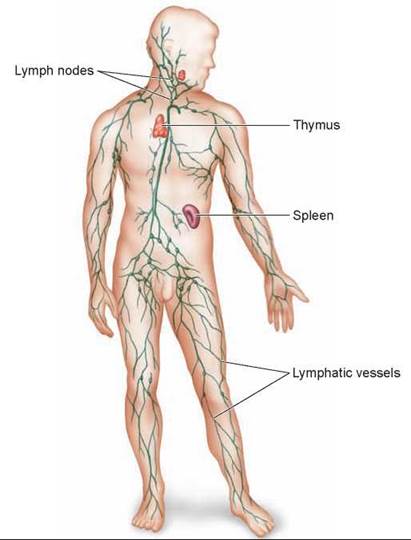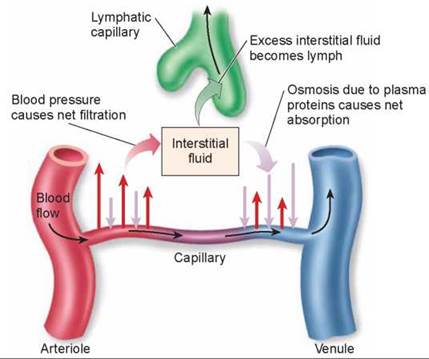THE LIVING WORLD
Unit Six. Animal Life
23.3. The Lymphatic System: Recovering Lost Fluid
The cardiovascular system is very leaky. Fluids are forced out across the thin walls of the capillaries by the pumping pressure of the heart. Although this loss is unavoidable—the circulatory system could not do its job of gas and metabolite exchange without tiny vessels with thin walls—it is important that the loss be made up. In your body, about 4 liters of fluid leave your cardiovascular system in this way each day, more than half the body’s total supply of about 5.6 liters of blood! To collect and recycle this fluid, the body uses a second circulatory system called the lymphatic system. Like the blood circulatory system, the lymphatic system is composed of a network of vessels; their distribution throughout the body is shown in figure 23.7.

Figure 23.7. The human lymphatic system.
The lymphatic system consists of lymphatic vessels and capillaries, lymph nodes, and lymphatic organs, including the spleen and thymus gland.
Fluid is filtered from the capillaries near their arteriole ends where the blood pressure is higher, as shown by the red arrows in figure 23.8 Most of the fluid returns to the blood capillaries by osmosis (the light purple arrows); however, excess fluid enters the open-ended lymphatic capillaries (indicated by the green arrow). These capillaries gather up liquid from the spaces surrounding cells and carry it through a series of progressively larger vessels to two large lymphatic vessels, which drain into veins in the lower part of the neck through one-way valves. Once within the lymphatic system, this fluid is called lymph.

Figure 23.8 Lymphatic capillaries reclaim fluid from interstitial fluid.
Blood pressure forces fluid from capillaries into the interstitial fluid surrounding cells, where it reenters the blood or drains into lymphatic capillaries.
Fluid is driven through the lymphatic system when its vessels are squeezed by the movements of the body’s muscles. The lymphatic vessels contain a series of one-way valves that permit movement only in the direction of the neck. In some cases, the lymphatic vessels also contract rhythmically. In many fishes, all amphibians and reptiles, bird embryos, and some adult birds, movement of lymph is propelled by lymph hearts.
The lymphatic system has three other important functions:
1. It returns proteins to the circulation. So much blood flows through the capillaries that there is significant leakage of blood proteins, even though the capillary walls are not very permeable to proteins (proteins are very large molecules). By recapturing the lost fluid, the lymphatic system also returns this lost protein.
2. It transports fats absorbed from the intestine. Lymph capillaries called lacteals penetrate the lining of the small intestine. These lacteals absorb fats from the digestive tract and eventually transport them to the circulatory system by way of the lymphatic system.
3. It aids in the body’s defense. Along a lymph vessel are swellings called lymph nodes, seen in figure 23.7, filled with white blood cells specialized for defense. The lymphatic system carries bacteria to the lymph nodes and spleen for destruction.
Key Learning Outcome 23.3. The lymphatic system returns to the circulatory system fluids and proteins that leak through the capillaries.